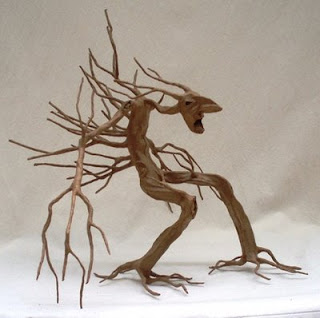Ucorno I/ Huorn I
 The Green Man, el hombre verde, es otra referencia en la cual Tolkien pudo haberse inspirado para la creación de los ents. The Green Man es un personaje del floklore relacionado con deidades vegetales de la naturaleza en muchas culturas (sobre todo europeas) a través del tiempo, y su representación se ha interpretado como un símbolo de "renacimiento" o mejor dicho del "ciclo del crecimiento de cada primavera".
The Green Man, el hombre verde, es otra referencia en la cual Tolkien pudo haberse inspirado para la creación de los ents. The Green Man es un personaje del floklore relacionado con deidades vegetales de la naturaleza en muchas culturas (sobre todo europeas) a través del tiempo, y su representación se ha interpretado como un símbolo de "renacimiento" o mejor dicho del "ciclo del crecimiento de cada primavera".Algunos especulan que la mitología de The Green Man se desarrolló de manera independiente en las tradiciones de diversas culturas antiguas y evolucionó en la gran variedad de relatos y leyendas que se han encontrado a través de la historia, sin embargo, se le ha vinculado directamente con el Dios Astado, que es un término utilizado por la Wicca y que unifica a numerosos dioses de la naturaleza de una amplia y dispersa serie de mitologías como la célta (Cernunnos), la inglesa (Herne el cazador), la egipcia (Osiris), la hindú (Pashupati), la griega (Pan) y la romana (Fauno). Todas estas deidades masculinas, habitantes y guardianes de los bosques, siempre son representa
 das con cuernos y se asociación con la naturaleza.
das con cuernos y se asociación con la naturaleza.La representación de The Green Man era la de un rostro humanizado rodeado o hecho por hojas de diversas formas y tamaños, de cuya boca o nariz a veces brotaban ramas o vides, mismas que remataban en otras hojas, flores o incluso frutos. Algunas veces, aparecía con una cornamenta de ciervo, por lo cual ese le relacionó también con el Dios Astado. Fue utilizado, sobre todo, como ornamento arquitectónico decorativo, y se les puede encontrar con frecuencia en tallas de iglesias y otros edificios (seculares o eclesiásticos), ya sea en columnas, fachadas o adornando puertas.
---------------
The Green Man, is another reference which Tolkien could have inspired for the creation of the ents. The Green Man is a character of the floklore related to vegetal deities of the nature in many cultures (mainly European) through time, and its representation has been interpreted like a symbol of "rebirth" or rather of "the cycle of the growth each spring".

Some speculate that the mythology of the Green Man was developed of independent way in the traditions of diverse ancient cultures and evolved in the great variety of stories and legends that has been found through the history, nevertheless, it had directly tie with the Horned God, that is a term used by the Wicca and that unifies numerous Gods of the nature of an ample one and disperses series of mythologies like the Celtic (Cernunnos), the English (Herne the hunter), the Egyptian (Osiris), the Hindu (Pashupati), the Greek (Pan) and the Roman (Faunus). All these masculine deities, inhabitants and guardians of the woods, always are represented with horns and associated with the nature.
The representation of the Green Man was a humanized face surrounded by or made from leaves of diverse forms and sizes, whose mouth or nose sometimes may sprout branches or vines, same that ended in other leaves, flowers or even fruits. Some times, deer's horns appeared on it, thus related to him also to the Horned God. It was used, mainly, like decorative architectonic ornament, and it is possible to foun them frequently in statures of churches and other buildings (secular or ecclesiastical), or in columns, facades or adorning doors.
Saludos/Greetings
César Espinosa
Alebrije-Egidio


Comentarios
Publicar un comentario
Gracias por dejarme tus comentarios sobre los textos y/o las piezas que te presento.